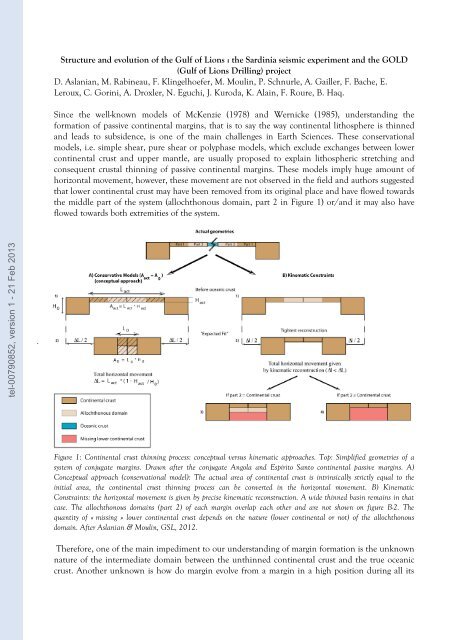Quantification des flux sédimentaires et de la subsidence du bassin ...
Quantification des flux sédimentaires et de la subsidence du bassin ...
Quantification des flux sédimentaires et de la subsidence du bassin ...
Create successful ePaper yourself
Turn your PDF publications into a flip-book with our unique Google optimized e-Paper software.
tel-00790852, version 1 - 21 Feb 2013<br />
Structure and evolution of the Gulf of Lions : the Sardinia seismic experiment and the GOLD<br />
(Gulf of Lions Drilling) project<br />
D. As<strong>la</strong>nian, M. Rabineau, F. Klingelhoefer, M. Moulin, P. Schnurle, A. Gailler, F. Bache, E.<br />
Leroux, C. Gorini, A. Droxler, N. Eguchi, J. Kuroda, K. A<strong>la</strong>in, F. Roure, B. Haq.<br />
Since the well-known mo<strong>de</strong>ls of McKenzie (1978) and Wernicke (1985), un<strong>de</strong>rstanding the<br />
formation of passive continental margins, that is to say the way continental lithosphere is thinned<br />
and leads to subsi<strong>de</strong>nce, is one of the main challenges in Earth Sciences. These conservational<br />
mo<strong>de</strong>ls, i.e. simple shear, pure shear or polyphase mo<strong>de</strong>ls, which exclu<strong>de</strong> exchanges b<strong>et</strong>ween lower<br />
continental crust and upper mantle, are usually proposed to exp<strong>la</strong>in lithospheric str<strong>et</strong>ching and<br />
consequent crustal thinning of passive continental margins. These mo<strong>de</strong>ls imply huge amount of<br />
horizontal movement, however, these movement are not observed in the field and authors suggested<br />
that lower continental crust may have been removed from its original p<strong>la</strong>ce and have flowed towards<br />
the middle part of the system (allochthonous domain, part 2 in Figure 1) or/and it may also have<br />
flowed towards both extremities of the system.<br />
Figure 1: Continental crust thinning process: conceptual versus kinematic approaches. Top: Simplified geom<strong>et</strong>ries of a<br />
system of conjugate margins. Drawn after the conjugate Ango<strong>la</strong> and Espirito Santo continental passive margins. A)<br />
Conceptual approach (conservational mo<strong>de</strong>l): The actual area of continental crust is intrinsically strictly equal to the<br />
initial area, the continental crust thinning process can be converted in the horizontal movement. B) Kinematic<br />
Constraints: the horizontal movement is given by precise kinematic reconstruction. A wi<strong>de</strong> thinned basin remains in that<br />
case. The allochthonous domains (part 2) of each margin over<strong>la</strong>p each other and are not shown on figure B-2. The<br />
quantity of « missing » lower continental crust <strong>de</strong>pends on the nature (lower continental or not) of the allochthonous<br />
domain. After As<strong>la</strong>nian & Moulin, GSL, 2012.<br />
Therefore, one of the main impediment to our un<strong>de</strong>rstanding of margin formation is the unknown<br />
nature of the intermediate domain b<strong>et</strong>ween the unthinned continental crust and the true oceanic<br />
crust. Another unknown is how do margin evolve from a margin in a high position <strong>du</strong>ring all its

















